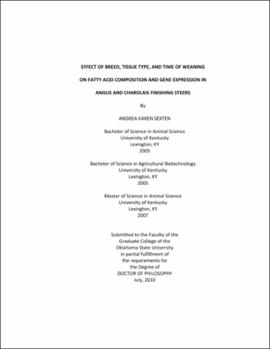| dc.contributor.advisor | Krehbiel, Clinton R. | |
| dc.contributor.author | Sexten, Andrea Karen | |
| dc.date.accessioned | 2013-11-26T08:22:39Z | |
| dc.date.available | 2013-11-26T08:22:39Z | |
| dc.date.issued | 2010-07 | |
| dc.identifier.uri | https://hdl.handle.net/11244/6622 | |
| dc.description.abstract | The effect of breed and tissue type on fatty acid composition and gene expression was evaluated using 33 steer calves. Calves were completely randomized to a 2 x 2 x 2 factorial treatment arrangement: sire breeds (Angus and Charolais), weaning dates (NW = normal weaned at approx. 210 days of age and LW = late weaned at approx. 300 days of age), and tissues (LM = longissimus muscle and ST = semitendinosus muscle). Weights were recorded at 28 d intervals to determine animal performance. Tissue biopsies were taken on d 127 and 128 of the finishing phase. All calves were harvested on d 138 and carcass data were collected. Total lipids were extracted from biopsies for fatty acid profile analysis using gas chromatography. Total RNA was extracted and hybridized to a bovine whole-genome 70-mer oligo array containing 24,000 long oligonucleotide probes used for gene expression analysis. Angus steers had greater weight gains (P=0.04), greater marbling scores (P = 0.002), more 12th-rib fat (P = 0.01), smaller REA (P = 0.01), and greater yield grades (P = 0.005) than Charolais steers. There were significant breed x time of weaning x tissue interactions for percent total SFA, UFA, MUFA, PUFA, n-3, and n-6. The n-3:n-6 ratio and percent total CLA differed due to the main effects of time of weaning and tissue. Several individual fatty acids had significant two-way interactions and differences due to time of weaning and tissue. The LM had almost two times more (55 vs. 30) differentially expressed genes than the ST. The LM and ST shared the common function of cell cycle in their most significant network. Angus steers had almost 4 times fewer (35 vs. 136) differentially expressed genes than the Charolais steers, and had no common functions in their top network. The desire to understanding the genetic mechanisms underlying changes in fatty acid composition of beef remains, and future research will need to be conducted before correlations between phenotype (fatty acid profile) and gene expression can be made. Beef is a highly nutritious and valued food, providing the essential fatty acids (n-3 and n-6) and several healthy fats (MUFA, PUFA, and CLA) to the human diet. These results provide insight into the challenge of developing and implementing a program to improve the healthfulness of beef utilizing existing variation to manipulate fat composition through management and selection. | |
| dc.format | application/pdf | |
| dc.language | en_US | |
| dc.rights | Copyright is held by the author who has granted the Oklahoma State University Library the non-exclusive right to share this material in its institutional repository. Contact Digital Library Services at lib-dls@okstate.edu or 405-744-9161 for the permission policy on the use, reproduction or distribution of this material. | |
| dc.title | Effect of breed, tissue type, and time of weaning on fatty acid composition and gene expression in Angus and Charolais finishing steers | |
| dc.contributor.committeeMember | Mateescu, Raluca G. | |
| dc.contributor.committeeMember | DeSilva, Udaya | |
| dc.contributor.committeeMember | Dillwith, Jack W. | |
| osu.filename | Sexten_okstate_0664D_11063 | |
| osu.accesstype | Open Access | |
| dc.type.genre | Dissertation | |
| dc.type.material | Text | |
| dc.subject.keywords | beef | |
| dc.subject.keywords | breed | |
| dc.subject.keywords | fatty acid | |
| dc.subject.keywords | gene expression | |
| dc.subject.keywords | tissue type | |
| dc.subject.keywords | weaning | |
| thesis.degree.discipline | Animal Science | |
| thesis.degree.grantor | Oklahoma State University | |
